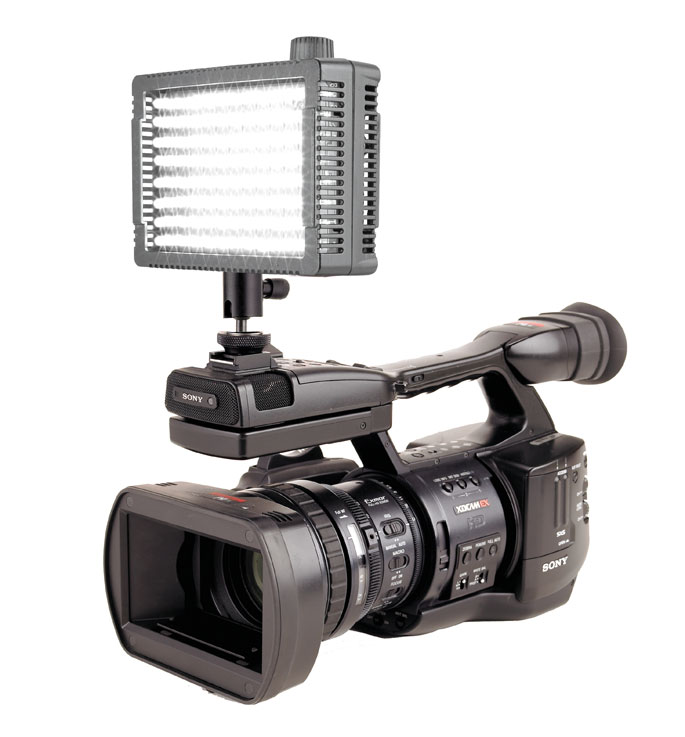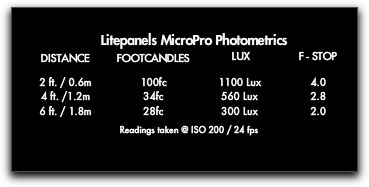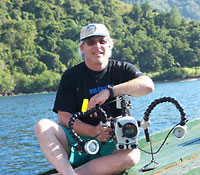|
   
| Review: - Lightpanel's Micro Pro |
July 2009
 Lightpanel's Micro Pro Lightpanel's Micro Pro
www.litepanels.com/ - $525.00
Review by Steve Douglas
There are many who have employed and relished the Lightpanel's Micro for its ease of use, long lasting light, and relatively inexpensive cost. I know some who never leave home without it. But, there are many who wanted more in this vein from Lightpanels and they have delivered in the form of the new Micro Pro. Someone there was reading and listening and in the new Micro Pro there are a number of significant improvements.
Let's revisit the still available and viable Litepanels Micro first. It produced heat free LED light and ran on 4 AA batteries lasting about 1.5 hours though there was a bit of an output drop off after 70 minutes. The light has always been flicker free for the many times I used it and was dimmable from 100% to 0. It attached to your camera's hot shoe and could be tilted up or down somewhat for greater lighting flexibility. I found it great in use to fill in the shadows and it was always small enough to pack away without taking up too much room. It comes with a flip down filter cover for the supplied colored gel and diffusion filter. This is where both this reviewer and others criticized it. The flip down filter holder frequently allowed the filter to slip down and out and never properly held the filter in. Sometimes it worked as it should and other times not so well. The bottom line was that you could not always trust it. The plastic casing gave you the feeling that it also could not take much abuse over the long term. On this last point, I was wrong. So far, the Micro has held up perfectly well to many shoots. I keep it stored in its' original box and, like all my gear, take pretty good care of it.
This leads me to the new Litepanels MicroPro. Considerably larger, at 5.5" x 4"x1.5", but not so much as to be a hindrance by size or weight, (without batteries it weights 4 ounces) the Micro Pro has literally twice as many LEDs from the Micro's 48 LEDs to the MicroPro's 96. Now running off of 6 AA batteries, the MicroPro produces twice the illumination of the Micro while adding little additional weight and a light that just feels sturdier. The plastic finish is pebbled as opposed to the smooth plastic of the Micro and whether this adds to the body strength, or not, I do not know, but it does feel more substantial.

The hot shoe mount is now a separate piece which integrates and screws neatly into the bottom of the MicroPro and the hot shoe and locking lever has moved away from the all plastic shoe and tightening knob of the Micro to a proper metal shoe and lever. This additionally gives the MicroPro far more latitude in how it is positioned by turning or tilting than the Micro offered. The MicroPro, like the Micro, may also be mounted on an optional base plate; however, I was not sent this to use or test. I did attach it to a Gorilla Pod and, with the Gorilla Pod's flexibility; I was able to place the MicroPro in several different and potentially useful configurations.
There are several options, which can be ordered in addition to the base plate for off camera usage. Spare color and diffusion gels, an AC power adapter, an articulated camera extension arm and even an underwater housing. I would have loved to test the underwater housing but that has not been placed at my disposal.
As I said, someone at Litepanels listened and the 3 filters that come with the light, now have tabs that fit securely into place where they dock on front of the light. There is no danger of them slipping out, falling and getting lost. The old fold down filter holder is no more.
The MicroPro remains flicker free no matter to what degree you have adjusted the dimmer. When first turned on, there is a brief flash of light and then you turn the dimmer on to the amount of illumination you are seeking. The light itself lends itself to a cooler illumination of 5600k but the 3200° Daylight to Tungsten conversion filter warms things up a bit. I would love for there to be some mini barn doors as part of the MicroPro so as to be able to better direct the direction of the light but, of course, then we would be adding both weight and cost.

My early tests showed the spread of light for the MicroPro to be significantly wider than the Micro though not particularly brighter. With the diffusion filter on, there remains a bit of a hot spot, which dissipates as you move the light further back. Of course, when doing so, the brightness of the light is also reduced upon the subject. As with all lighting kits and situations, one needs to balance the MicroPro's illumination evenly over the subject accomplished by careful placement and the amount of light used.
I applaud Litepanels for the many advancements that can be found in the MicroPro. There is no debate that any videographer or photographer will appreciate these improvements and for those who are seeking a cam mounted light that won't burn the talent, the MicroPro is the way to go.
 Steve Douglas is a certified Apple Pro for Final Cut Pro 6 and underwater videographer. A winner of the 1999 Pacific Coast Underwater Film Competition, 2003 IVIE competition, 2004 Los Angeles Underwater Photographic competition, and the prestigious 2005 International Beneath the Sea Film Competition, where he also won the Stan Waterman Award for Excellence in Underwater Videography and 'Diver of the Year', Steve was a safety diver on the feature film "The Deep Blue Sea", contributed footage to the Seaworld Park's Atlantis production, and productions for National Geographic and the History channels. Steve is also feature writer for Asian Diver Magazine and is one of the founding organizers of the San Diego UnderSea Film Exhibition. He is available for both private and group seminars for Final Cut Pro and leads underwater filming expeditions and African safaris with upcoming excursions to the Red Sea and Egypt for Nov.2009, Feel free to contact him if you are interested in joining Steve on any of these exciting trips. www.worldfilmsandtravel.com
Steve Douglas is a certified Apple Pro for Final Cut Pro 6 and underwater videographer. A winner of the 1999 Pacific Coast Underwater Film Competition, 2003 IVIE competition, 2004 Los Angeles Underwater Photographic competition, and the prestigious 2005 International Beneath the Sea Film Competition, where he also won the Stan Waterman Award for Excellence in Underwater Videography and 'Diver of the Year', Steve was a safety diver on the feature film "The Deep Blue Sea", contributed footage to the Seaworld Park's Atlantis production, and productions for National Geographic and the History channels. Steve is also feature writer for Asian Diver Magazine and is one of the founding organizers of the San Diego UnderSea Film Exhibition. He is available for both private and group seminars for Final Cut Pro and leads underwater filming expeditions and African safaris with upcoming excursions to the Red Sea and Egypt for Nov.2009, Feel free to contact him if you are interested in joining Steve on any of these exciting trips. www.worldfilmsandtravel.com
copyright © Steve Douglas 2009
This article first appeared on www.kenstone.net and is reprinted here with permission.
All screen captures and textual references are the property and trademark of their creators/owners/publishers.
|